Australian Red Cross: An Investigative Study of Duties & Effectiveness
VerifiedAdded on 2023/06/10
|7
|1469
|380
Report
AI Summary
This report provides an investigative study of the Australian Red Cross, examining its fundamental functioning purpose in assisting communities facing social, economic, and natural challenges. It highlights the organization's reliance on donations and fundraising, along with community mobilization through various campaigns. The report delves into the theoretical underpinnings, such as creating social justice platforms and promoting community recovery from disasters. It evaluates the organization's processes and practices, including research, community organization, and the involvement of professionals. Funding sources and government involvement are discussed, emphasizing the collaborative efforts in coordinating humanitarian activities. The report concludes by reiterating the Red Cross's role in addressing societal challenges through public funding and individual fundraising, with the government providing essential coordination.
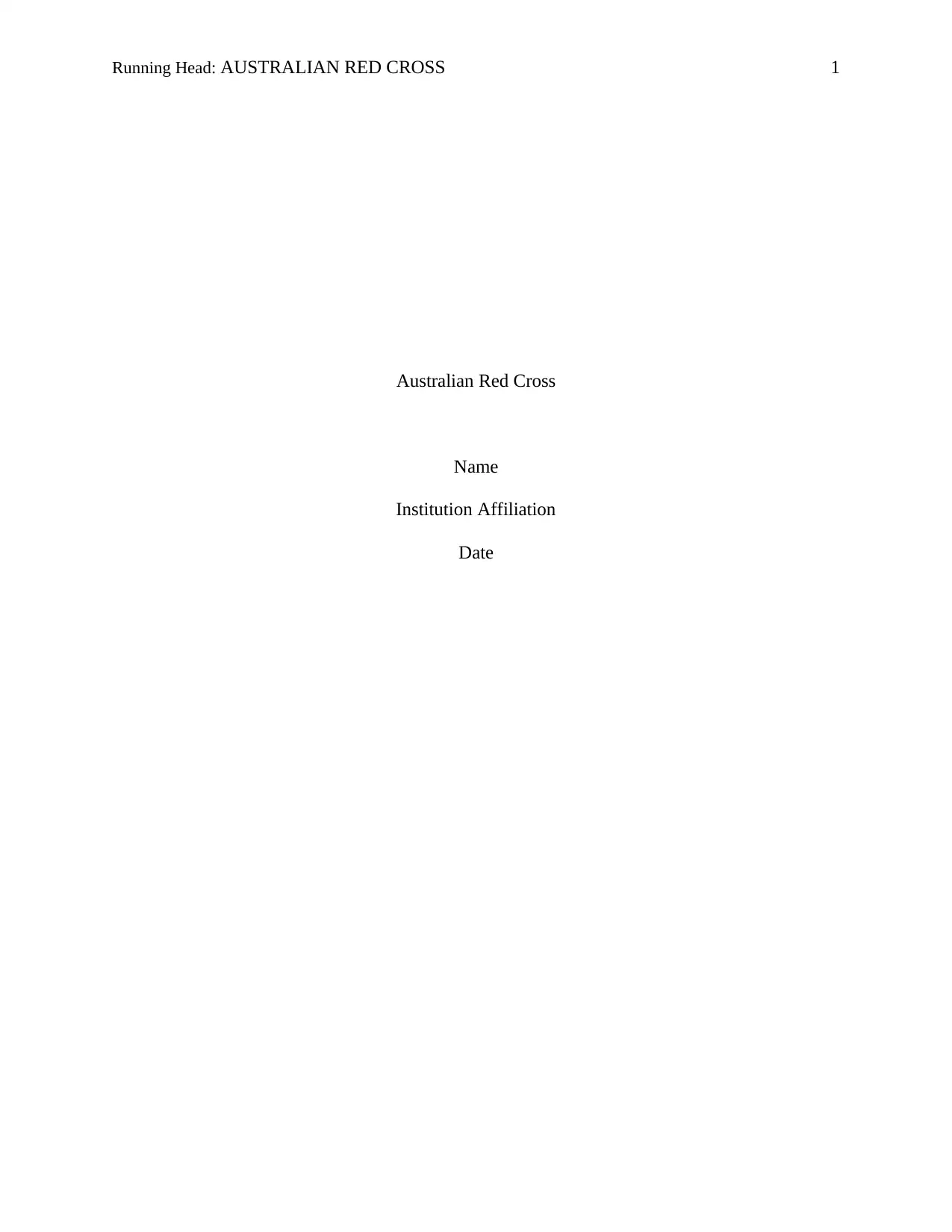
Running Head: AUSTRALIAN RED CROSS 1
Australian Red Cross
Name
Institution Affiliation
Date
Australian Red Cross
Name
Institution Affiliation
Date
Paraphrase This Document
Need a fresh take? Get an instant paraphrase of this document with our AI Paraphraser
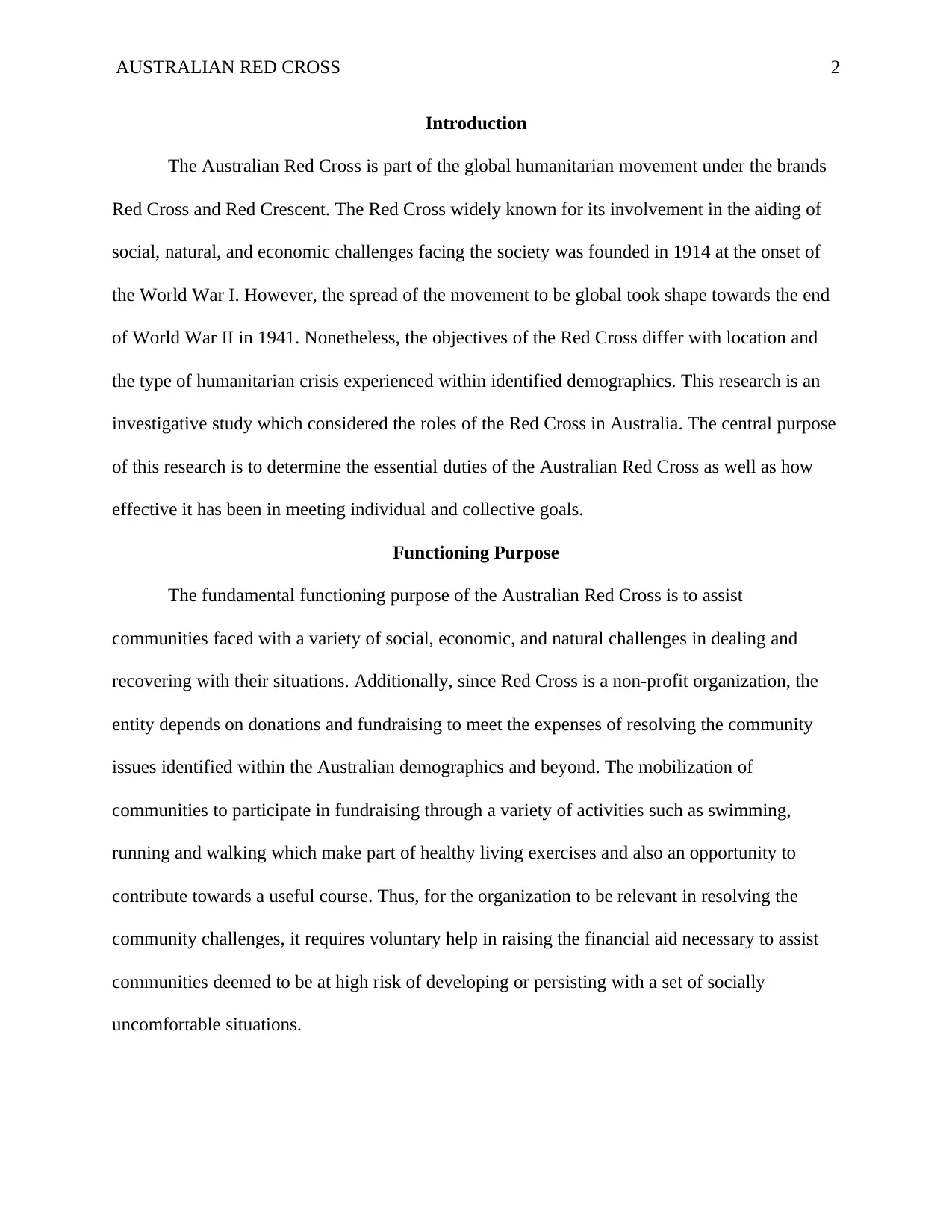
AUSTRALIAN RED CROSS 2
Introduction
The Australian Red Cross is part of the global humanitarian movement under the brands
Red Cross and Red Crescent. The Red Cross widely known for its involvement in the aiding of
social, natural, and economic challenges facing the society was founded in 1914 at the onset of
the World War I. However, the spread of the movement to be global took shape towards the end
of World War II in 1941. Nonetheless, the objectives of the Red Cross differ with location and
the type of humanitarian crisis experienced within identified demographics. This research is an
investigative study which considered the roles of the Red Cross in Australia. The central purpose
of this research is to determine the essential duties of the Australian Red Cross as well as how
effective it has been in meeting individual and collective goals.
Functioning Purpose
The fundamental functioning purpose of the Australian Red Cross is to assist
communities faced with a variety of social, economic, and natural challenges in dealing and
recovering with their situations. Additionally, since Red Cross is a non-profit organization, the
entity depends on donations and fundraising to meet the expenses of resolving the community
issues identified within the Australian demographics and beyond. The mobilization of
communities to participate in fundraising through a variety of activities such as swimming,
running and walking which make part of healthy living exercises and also an opportunity to
contribute towards a useful course. Thus, for the organization to be relevant in resolving the
community challenges, it requires voluntary help in raising the financial aid necessary to assist
communities deemed to be at high risk of developing or persisting with a set of socially
uncomfortable situations.
Introduction
The Australian Red Cross is part of the global humanitarian movement under the brands
Red Cross and Red Crescent. The Red Cross widely known for its involvement in the aiding of
social, natural, and economic challenges facing the society was founded in 1914 at the onset of
the World War I. However, the spread of the movement to be global took shape towards the end
of World War II in 1941. Nonetheless, the objectives of the Red Cross differ with location and
the type of humanitarian crisis experienced within identified demographics. This research is an
investigative study which considered the roles of the Red Cross in Australia. The central purpose
of this research is to determine the essential duties of the Australian Red Cross as well as how
effective it has been in meeting individual and collective goals.
Functioning Purpose
The fundamental functioning purpose of the Australian Red Cross is to assist
communities faced with a variety of social, economic, and natural challenges in dealing and
recovering with their situations. Additionally, since Red Cross is a non-profit organization, the
entity depends on donations and fundraising to meet the expenses of resolving the community
issues identified within the Australian demographics and beyond. The mobilization of
communities to participate in fundraising through a variety of activities such as swimming,
running and walking which make part of healthy living exercises and also an opportunity to
contribute towards a useful course. Thus, for the organization to be relevant in resolving the
community challenges, it requires voluntary help in raising the financial aid necessary to assist
communities deemed to be at high risk of developing or persisting with a set of socially
uncomfortable situations.
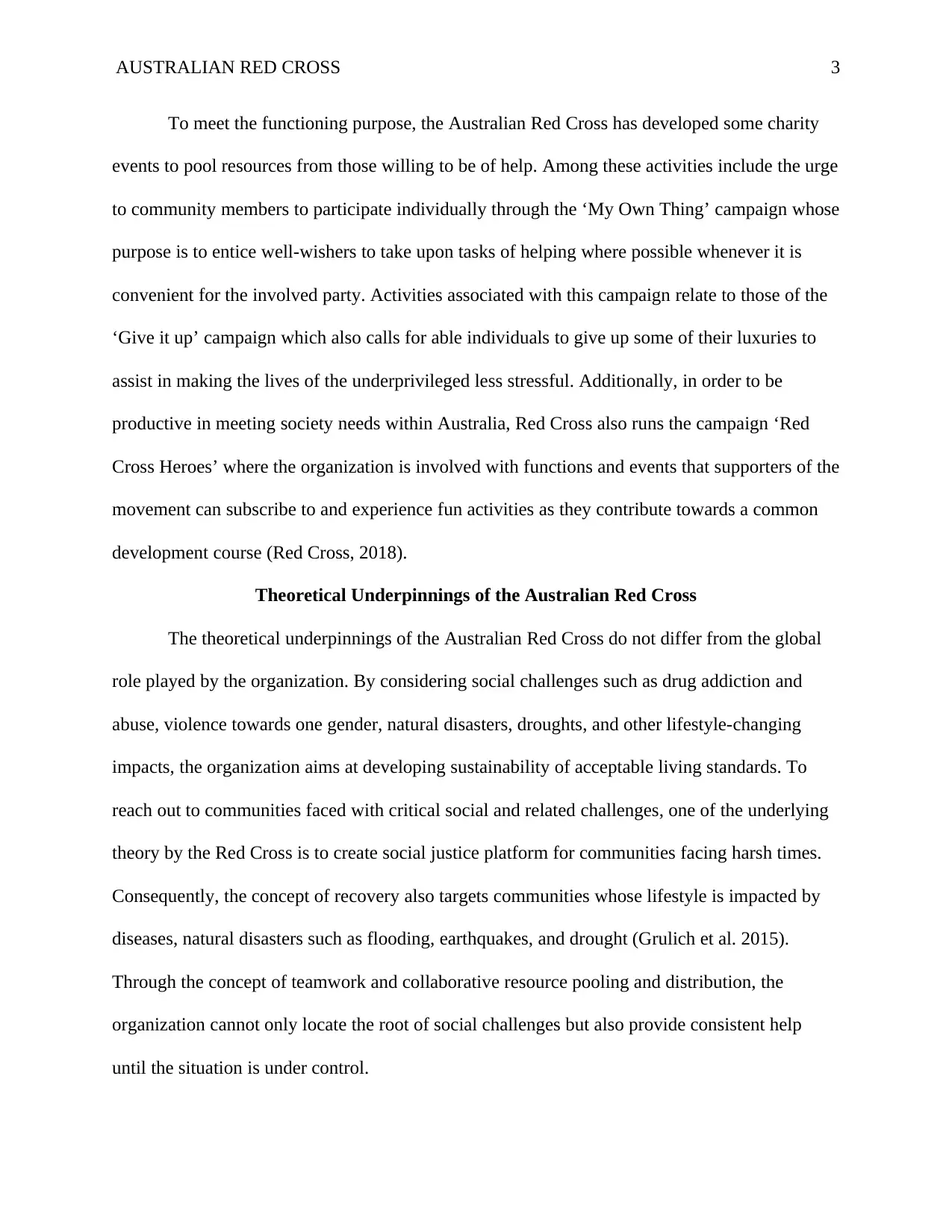
AUSTRALIAN RED CROSS 3
To meet the functioning purpose, the Australian Red Cross has developed some charity
events to pool resources from those willing to be of help. Among these activities include the urge
to community members to participate individually through the ‘My Own Thing’ campaign whose
purpose is to entice well-wishers to take upon tasks of helping where possible whenever it is
convenient for the involved party. Activities associated with this campaign relate to those of the
‘Give it up’ campaign which also calls for able individuals to give up some of their luxuries to
assist in making the lives of the underprivileged less stressful. Additionally, in order to be
productive in meeting society needs within Australia, Red Cross also runs the campaign ‘Red
Cross Heroes’ where the organization is involved with functions and events that supporters of the
movement can subscribe to and experience fun activities as they contribute towards a common
development course (Red Cross, 2018).
Theoretical Underpinnings of the Australian Red Cross
The theoretical underpinnings of the Australian Red Cross do not differ from the global
role played by the organization. By considering social challenges such as drug addiction and
abuse, violence towards one gender, natural disasters, droughts, and other lifestyle-changing
impacts, the organization aims at developing sustainability of acceptable living standards. To
reach out to communities faced with critical social and related challenges, one of the underlying
theory by the Red Cross is to create social justice platform for communities facing harsh times.
Consequently, the concept of recovery also targets communities whose lifestyle is impacted by
diseases, natural disasters such as flooding, earthquakes, and drought (Grulich et al. 2015).
Through the concept of teamwork and collaborative resource pooling and distribution, the
organization cannot only locate the root of social challenges but also provide consistent help
until the situation is under control.
To meet the functioning purpose, the Australian Red Cross has developed some charity
events to pool resources from those willing to be of help. Among these activities include the urge
to community members to participate individually through the ‘My Own Thing’ campaign whose
purpose is to entice well-wishers to take upon tasks of helping where possible whenever it is
convenient for the involved party. Activities associated with this campaign relate to those of the
‘Give it up’ campaign which also calls for able individuals to give up some of their luxuries to
assist in making the lives of the underprivileged less stressful. Additionally, in order to be
productive in meeting society needs within Australia, Red Cross also runs the campaign ‘Red
Cross Heroes’ where the organization is involved with functions and events that supporters of the
movement can subscribe to and experience fun activities as they contribute towards a common
development course (Red Cross, 2018).
Theoretical Underpinnings of the Australian Red Cross
The theoretical underpinnings of the Australian Red Cross do not differ from the global
role played by the organization. By considering social challenges such as drug addiction and
abuse, violence towards one gender, natural disasters, droughts, and other lifestyle-changing
impacts, the organization aims at developing sustainability of acceptable living standards. To
reach out to communities faced with critical social and related challenges, one of the underlying
theory by the Red Cross is to create social justice platform for communities facing harsh times.
Consequently, the concept of recovery also targets communities whose lifestyle is impacted by
diseases, natural disasters such as flooding, earthquakes, and drought (Grulich et al. 2015).
Through the concept of teamwork and collaborative resource pooling and distribution, the
organization cannot only locate the root of social challenges but also provide consistent help
until the situation is under control.
⊘ This is a preview!⊘
Do you want full access?
Subscribe today to unlock all pages.

Trusted by 1+ million students worldwide
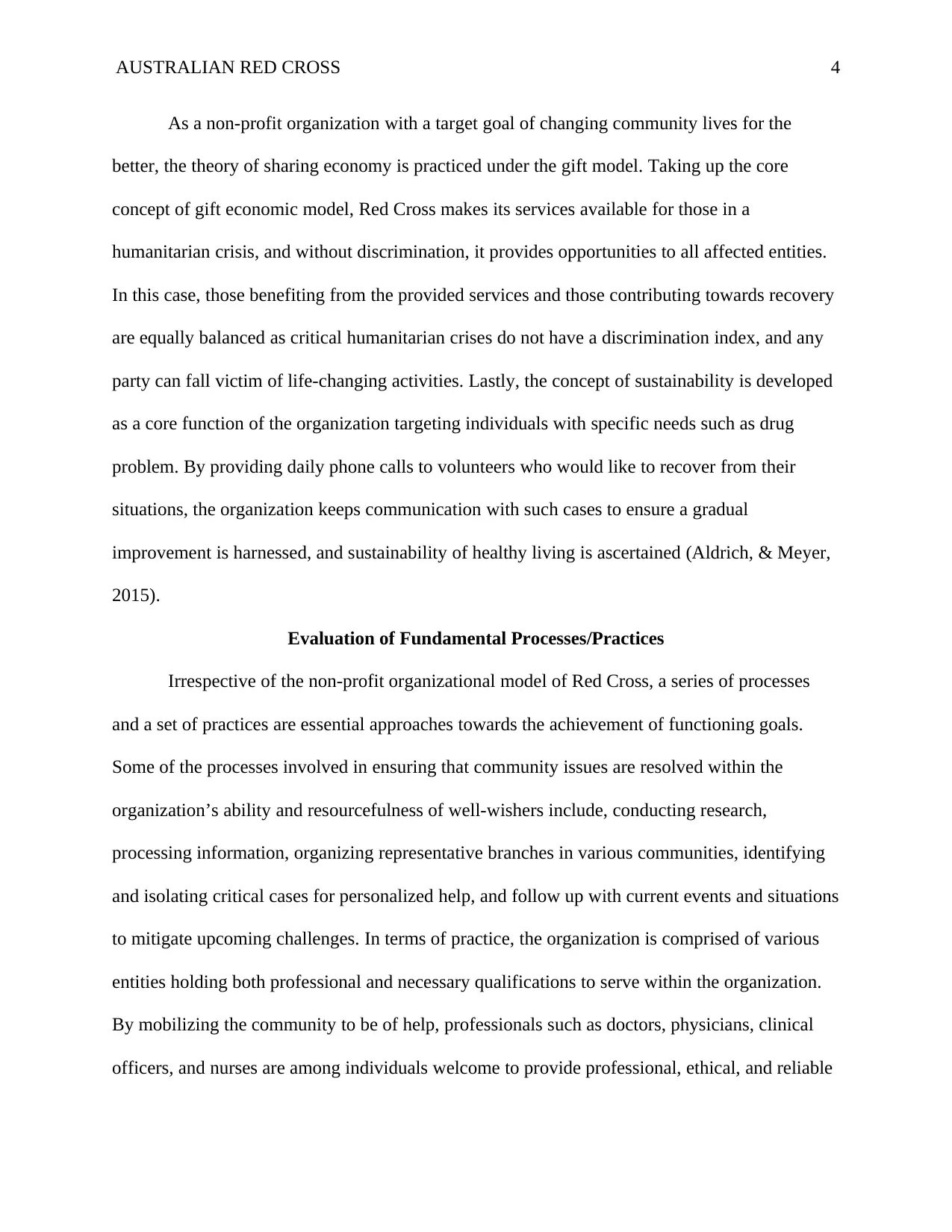
AUSTRALIAN RED CROSS 4
As a non-profit organization with a target goal of changing community lives for the
better, the theory of sharing economy is practiced under the gift model. Taking up the core
concept of gift economic model, Red Cross makes its services available for those in a
humanitarian crisis, and without discrimination, it provides opportunities to all affected entities.
In this case, those benefiting from the provided services and those contributing towards recovery
are equally balanced as critical humanitarian crises do not have a discrimination index, and any
party can fall victim of life-changing activities. Lastly, the concept of sustainability is developed
as a core function of the organization targeting individuals with specific needs such as drug
problem. By providing daily phone calls to volunteers who would like to recover from their
situations, the organization keeps communication with such cases to ensure a gradual
improvement is harnessed, and sustainability of healthy living is ascertained (Aldrich, & Meyer,
2015).
Evaluation of Fundamental Processes/Practices
Irrespective of the non-profit organizational model of Red Cross, a series of processes
and a set of practices are essential approaches towards the achievement of functioning goals.
Some of the processes involved in ensuring that community issues are resolved within the
organization’s ability and resourcefulness of well-wishers include, conducting research,
processing information, organizing representative branches in various communities, identifying
and isolating critical cases for personalized help, and follow up with current events and situations
to mitigate upcoming challenges. In terms of practice, the organization is comprised of various
entities holding both professional and necessary qualifications to serve within the organization.
By mobilizing the community to be of help, professionals such as doctors, physicians, clinical
officers, and nurses are among individuals welcome to provide professional, ethical, and reliable
As a non-profit organization with a target goal of changing community lives for the
better, the theory of sharing economy is practiced under the gift model. Taking up the core
concept of gift economic model, Red Cross makes its services available for those in a
humanitarian crisis, and without discrimination, it provides opportunities to all affected entities.
In this case, those benefiting from the provided services and those contributing towards recovery
are equally balanced as critical humanitarian crises do not have a discrimination index, and any
party can fall victim of life-changing activities. Lastly, the concept of sustainability is developed
as a core function of the organization targeting individuals with specific needs such as drug
problem. By providing daily phone calls to volunteers who would like to recover from their
situations, the organization keeps communication with such cases to ensure a gradual
improvement is harnessed, and sustainability of healthy living is ascertained (Aldrich, & Meyer,
2015).
Evaluation of Fundamental Processes/Practices
Irrespective of the non-profit organizational model of Red Cross, a series of processes
and a set of practices are essential approaches towards the achievement of functioning goals.
Some of the processes involved in ensuring that community issues are resolved within the
organization’s ability and resourcefulness of well-wishers include, conducting research,
processing information, organizing representative branches in various communities, identifying
and isolating critical cases for personalized help, and follow up with current events and situations
to mitigate upcoming challenges. In terms of practice, the organization is comprised of various
entities holding both professional and necessary qualifications to serve within the organization.
By mobilizing the community to be of help, professionals such as doctors, physicians, clinical
officers, and nurses are among individuals welcome to provide professional, ethical, and reliable
Paraphrase This Document
Need a fresh take? Get an instant paraphrase of this document with our AI Paraphraser
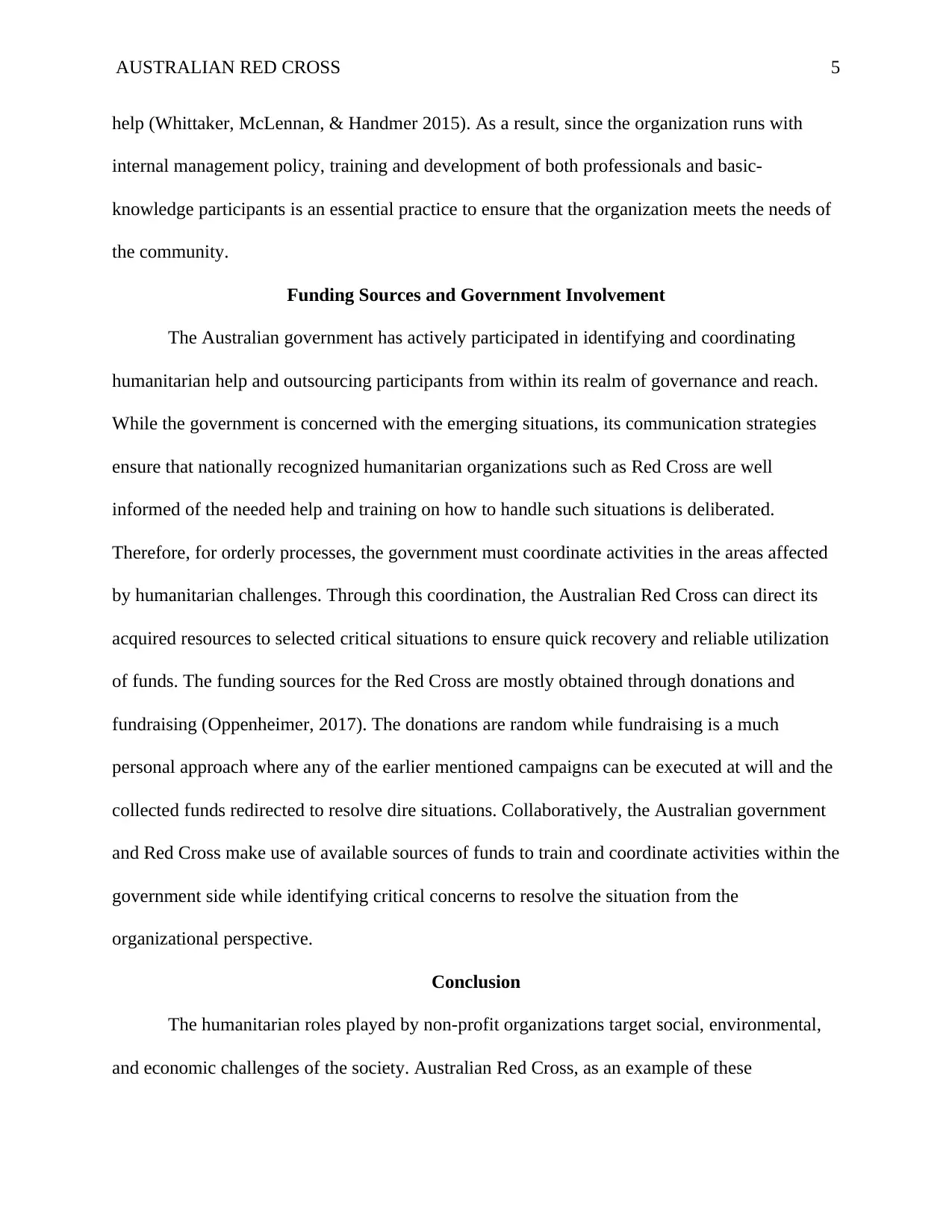
AUSTRALIAN RED CROSS 5
help (Whittaker, McLennan, & Handmer 2015). As a result, since the organization runs with
internal management policy, training and development of both professionals and basic-
knowledge participants is an essential practice to ensure that the organization meets the needs of
the community.
Funding Sources and Government Involvement
The Australian government has actively participated in identifying and coordinating
humanitarian help and outsourcing participants from within its realm of governance and reach.
While the government is concerned with the emerging situations, its communication strategies
ensure that nationally recognized humanitarian organizations such as Red Cross are well
informed of the needed help and training on how to handle such situations is deliberated.
Therefore, for orderly processes, the government must coordinate activities in the areas affected
by humanitarian challenges. Through this coordination, the Australian Red Cross can direct its
acquired resources to selected critical situations to ensure quick recovery and reliable utilization
of funds. The funding sources for the Red Cross are mostly obtained through donations and
fundraising (Oppenheimer, 2017). The donations are random while fundraising is a much
personal approach where any of the earlier mentioned campaigns can be executed at will and the
collected funds redirected to resolve dire situations. Collaboratively, the Australian government
and Red Cross make use of available sources of funds to train and coordinate activities within the
government side while identifying critical concerns to resolve the situation from the
organizational perspective.
Conclusion
The humanitarian roles played by non-profit organizations target social, environmental,
and economic challenges of the society. Australian Red Cross, as an example of these
help (Whittaker, McLennan, & Handmer 2015). As a result, since the organization runs with
internal management policy, training and development of both professionals and basic-
knowledge participants is an essential practice to ensure that the organization meets the needs of
the community.
Funding Sources and Government Involvement
The Australian government has actively participated in identifying and coordinating
humanitarian help and outsourcing participants from within its realm of governance and reach.
While the government is concerned with the emerging situations, its communication strategies
ensure that nationally recognized humanitarian organizations such as Red Cross are well
informed of the needed help and training on how to handle such situations is deliberated.
Therefore, for orderly processes, the government must coordinate activities in the areas affected
by humanitarian challenges. Through this coordination, the Australian Red Cross can direct its
acquired resources to selected critical situations to ensure quick recovery and reliable utilization
of funds. The funding sources for the Red Cross are mostly obtained through donations and
fundraising (Oppenheimer, 2017). The donations are random while fundraising is a much
personal approach where any of the earlier mentioned campaigns can be executed at will and the
collected funds redirected to resolve dire situations. Collaboratively, the Australian government
and Red Cross make use of available sources of funds to train and coordinate activities within the
government side while identifying critical concerns to resolve the situation from the
organizational perspective.
Conclusion
The humanitarian roles played by non-profit organizations target social, environmental,
and economic challenges of the society. Australian Red Cross, as an example of these
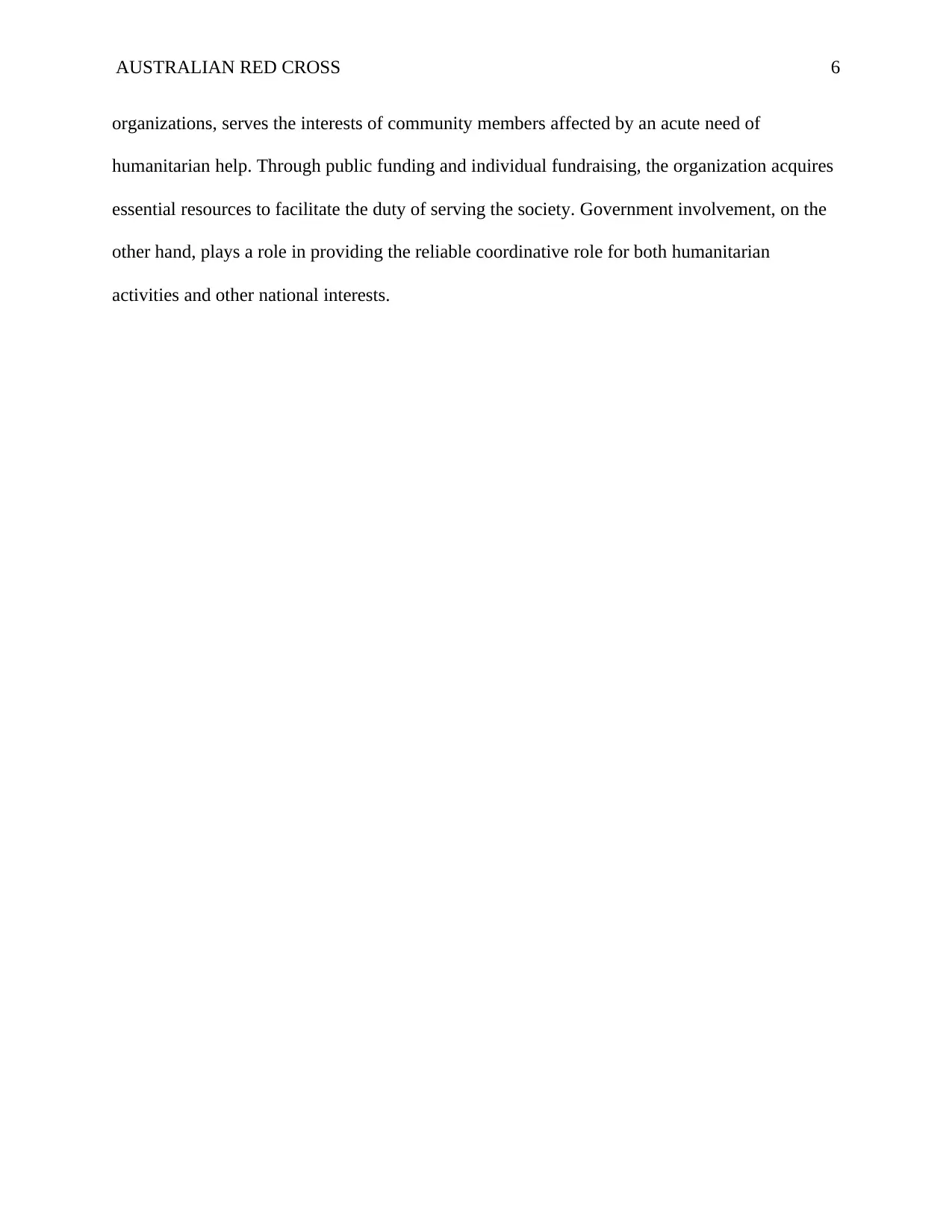
AUSTRALIAN RED CROSS 6
organizations, serves the interests of community members affected by an acute need of
humanitarian help. Through public funding and individual fundraising, the organization acquires
essential resources to facilitate the duty of serving the society. Government involvement, on the
other hand, plays a role in providing the reliable coordinative role for both humanitarian
activities and other national interests.
organizations, serves the interests of community members affected by an acute need of
humanitarian help. Through public funding and individual fundraising, the organization acquires
essential resources to facilitate the duty of serving the society. Government involvement, on the
other hand, plays a role in providing the reliable coordinative role for both humanitarian
activities and other national interests.
⊘ This is a preview!⊘
Do you want full access?
Subscribe today to unlock all pages.

Trusted by 1+ million students worldwide
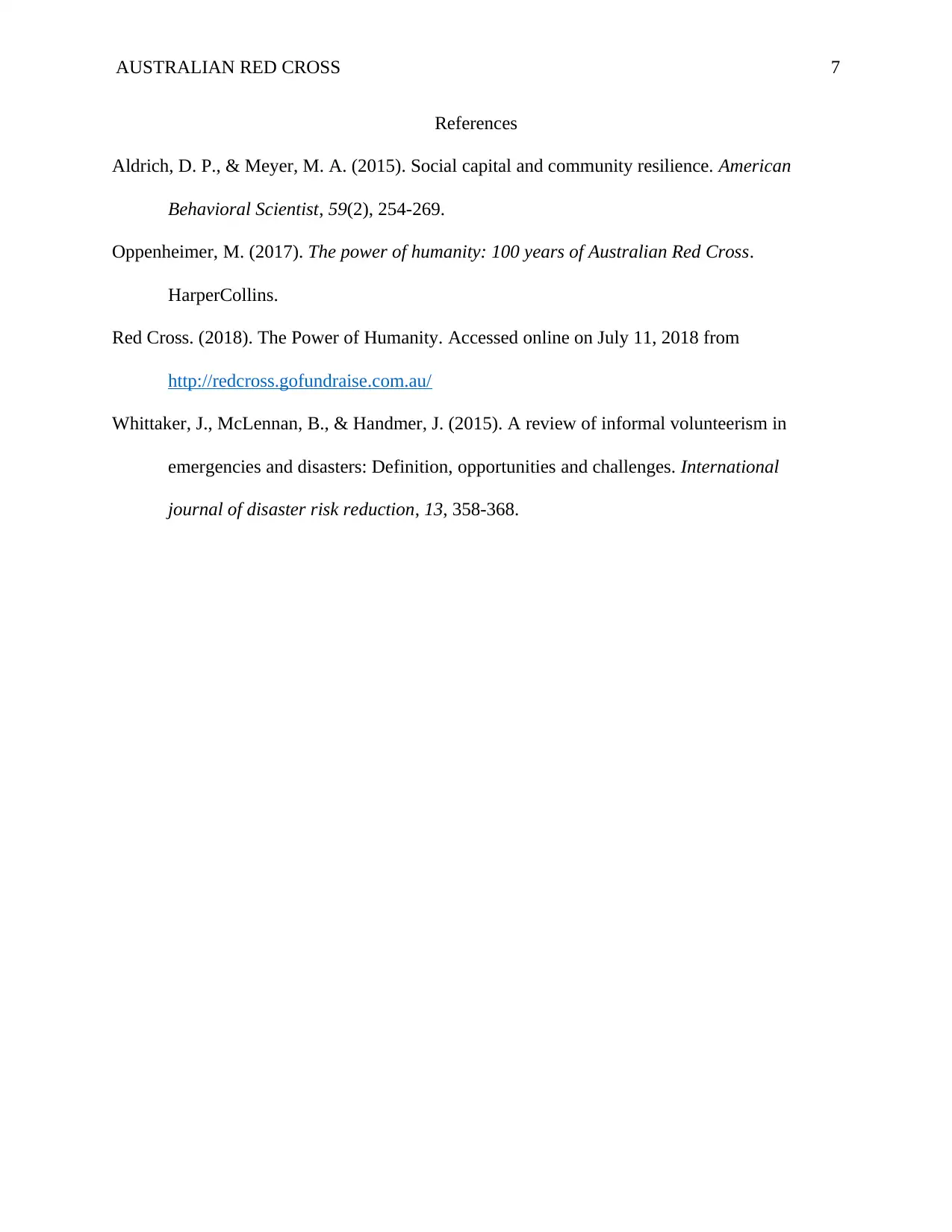
AUSTRALIAN RED CROSS 7
References
Aldrich, D. P., & Meyer, M. A. (2015). Social capital and community resilience. American
Behavioral Scientist, 59(2), 254-269.
Oppenheimer, M. (2017). The power of humanity: 100 years of Australian Red Cross.
HarperCollins.
Red Cross. (2018). The Power of Humanity. Accessed online on July 11, 2018 from
http://redcross.gofundraise.com.au/
Whittaker, J., McLennan, B., & Handmer, J. (2015). A review of informal volunteerism in
emergencies and disasters: Definition, opportunities and challenges. International
journal of disaster risk reduction, 13, 358-368.
References
Aldrich, D. P., & Meyer, M. A. (2015). Social capital and community resilience. American
Behavioral Scientist, 59(2), 254-269.
Oppenheimer, M. (2017). The power of humanity: 100 years of Australian Red Cross.
HarperCollins.
Red Cross. (2018). The Power of Humanity. Accessed online on July 11, 2018 from
http://redcross.gofundraise.com.au/
Whittaker, J., McLennan, B., & Handmer, J. (2015). A review of informal volunteerism in
emergencies and disasters: Definition, opportunities and challenges. International
journal of disaster risk reduction, 13, 358-368.
1 out of 7
Related Documents
Your All-in-One AI-Powered Toolkit for Academic Success.
+13062052269
info@desklib.com
Available 24*7 on WhatsApp / Email
![[object Object]](/_next/static/media/star-bottom.7253800d.svg)
Unlock your academic potential
Copyright © 2020–2025 A2Z Services. All Rights Reserved. Developed and managed by ZUCOL.





